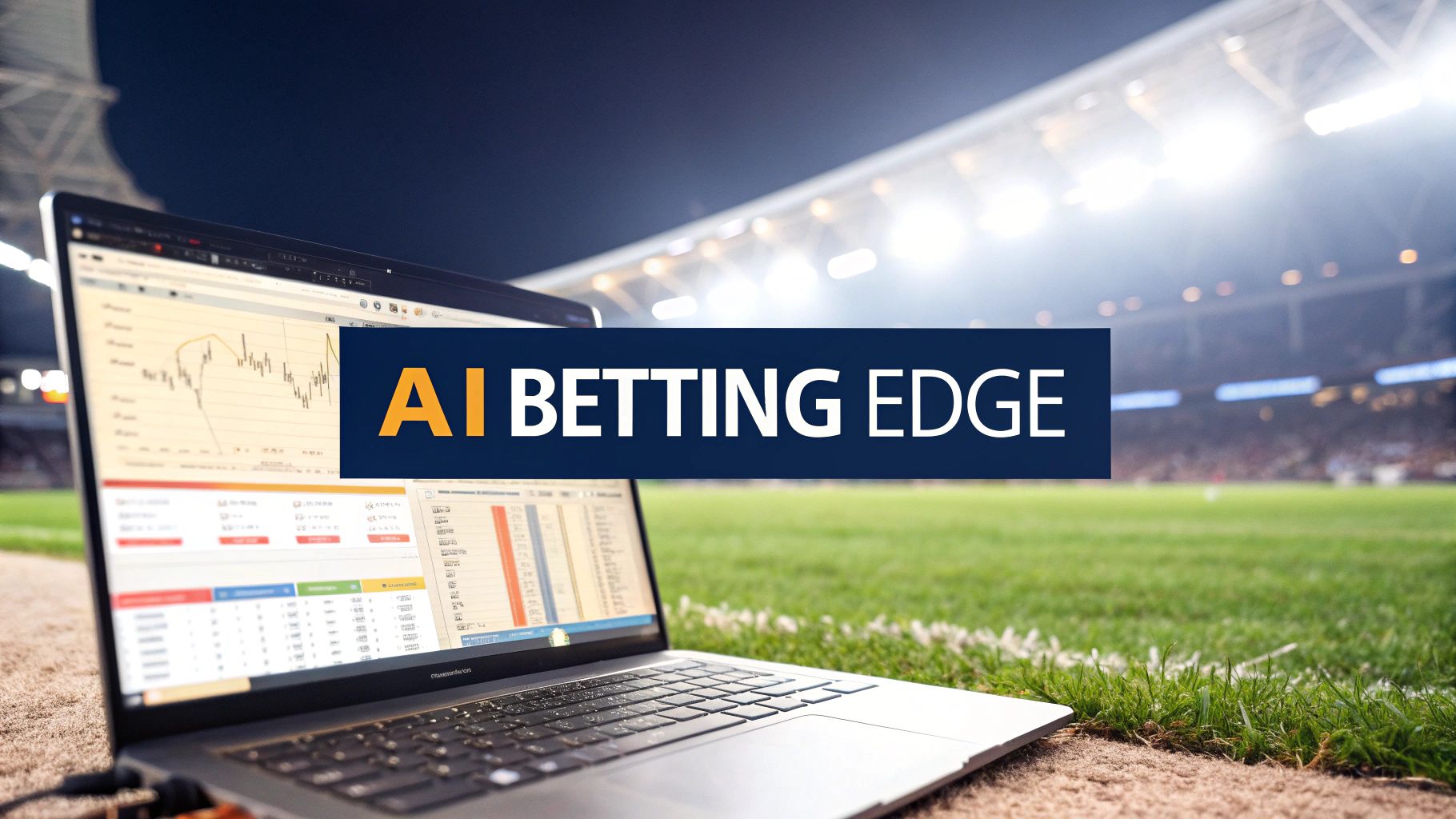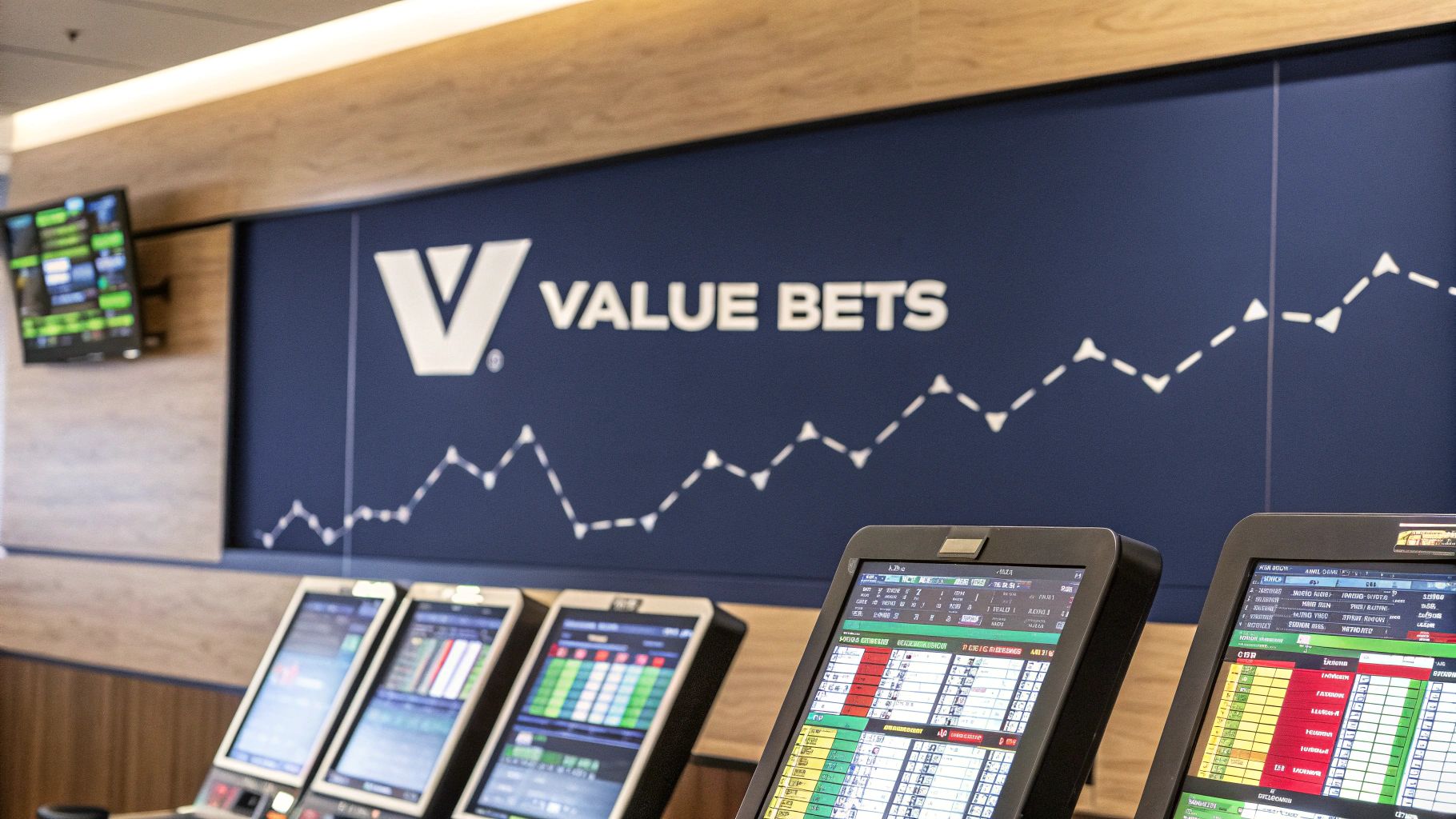
A Bettor's Guide to Value Bets & Odds Movement
Unlock smarter betting with our guide to value bets & odds movement. Learn to spot undervalued odds and use market shifts to your advantage.
Finding a value bet is a bit like spotting a designer watch at a car boot sale for a fraction of its price. The seller has put a price on it (the odds), but you've got the expertise to see its true worth. To consistently find these hidden gems, you need to get to grips with value bets & odds movement and understand how the two are deeply intertwined.
Seeing the Matrix Behind Bookmaker Odds
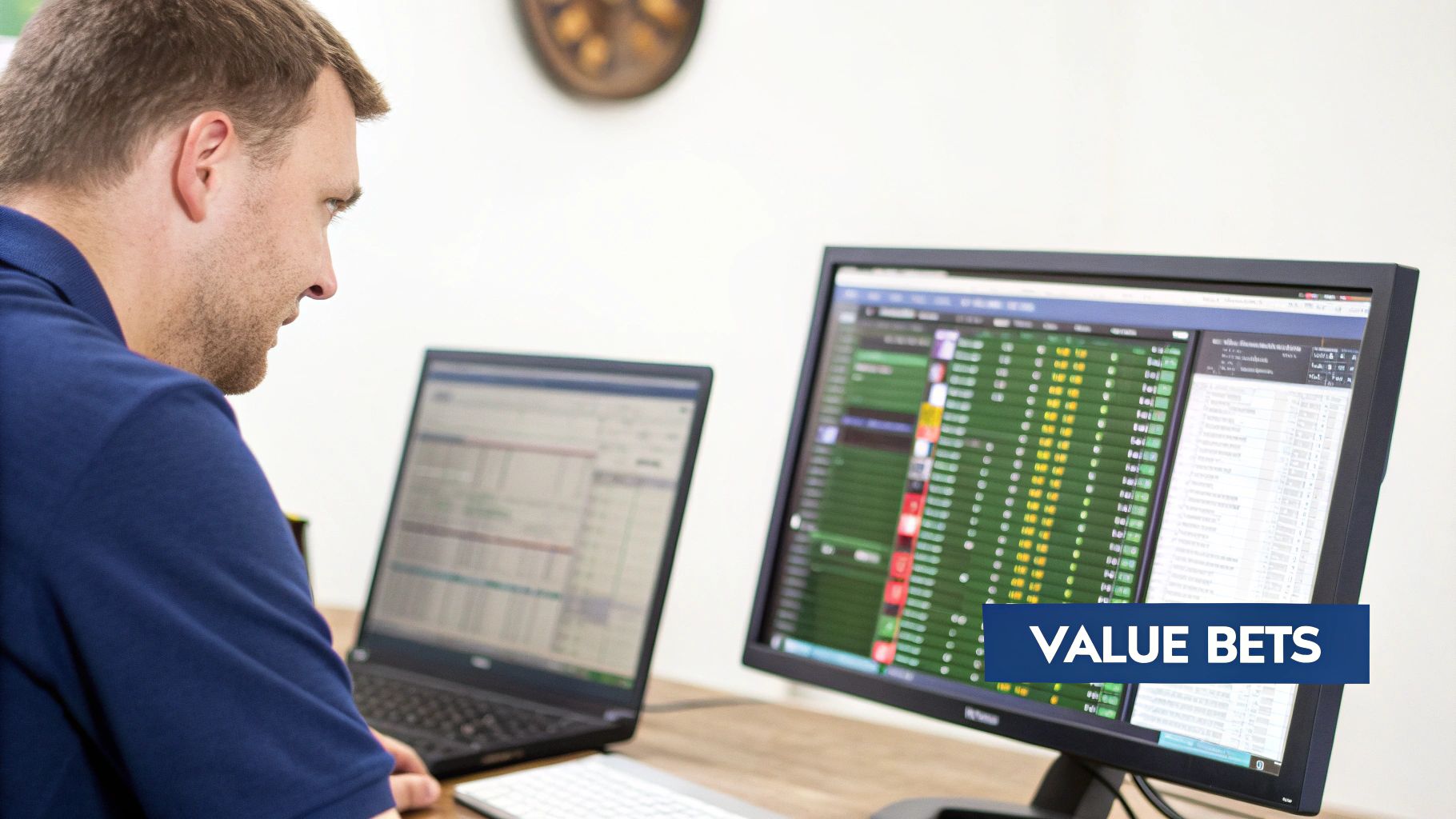
Ever get the feeling that bookmakers are playing a completely different game? That's because they are, and this guide is here to teach you the rules. We're cutting through the complicated jargon to break down how odds are really set and, more importantly, why they're constantly on the move.
Grasping this is your first real step from being a casual punter to becoming a sharp analyst who knows how to spot when the house has got its prices wrong.
Think of bookmakers as market makers, not fortune tellers. Their initial odds aren't just a pure prediction of who will win. They're a carefully crafted number designed to attract balanced betting on every possible outcome. This strategy ensures they can pay out the winners with the money collected from the losers, all while pocketing a commission for themselves—often called the "vig" or "juice."
How Initial Odds Are Created
To set their opening lines, bookmakers rely on a powerful combination of high-tech algorithms and human expertise. They crunch an incredible amount of data to figure out the baseline probability for everything that could happen in an event.
- Statistical Modelling: This is the deep dive into the numbers—historical performance, recent form, head-to-head records, and all sorts of advanced metrics.
- Expert Analysis: Human traders then step in to add the context that an algorithm might miss, like a specific tactical mismatch, dressing room morale, or even the psychological pressure of a derby.
- Market Positioning: They also keep a close eye on their competitors' odds to make sure their own prices are appealing enough to attract punters, yet still built for profit.
The opening line isn't the final word; it's the opening offer. It's an invitation for the market to share its opinion, and this is where the fascinating story of odds movement truly begins.
Why Odds Never Stand Still
Once those odds are live, they stop being static numbers. They become dynamic, living things that react to market forces, a lot like stock prices on an exchange. This is exactly where your opportunity to find value is born.
And it's a dynamic environment that's growing at a blistering pace. The Romanian online gambling market, for instance, saw its gross gaming yield hit a staggering 900 million euros, almost doubling in just three years. You can read more about this expanding market and its opportunities to see just how much is happening.
So, what makes these odds shift? A few key factors are always at play:
- Weight of Money: This is the single biggest driver. If a flood of money comes in on one team, the bookie will quickly shorten their odds (making them less attractive) and lengthen the odds on the other side. They're not changing their mind about who will win; they're just trying to encourage bets on the other outcome to balance their books and reduce their risk.
- New Information: The game can change in an instant. Breaking news like a star player's last-minute injury, a sudden downpour changing pitch conditions, or a surprise team selection will force an immediate and dramatic adjustment to the odds.
- Market Sentiment: Sometimes, odds move simply because of public opinion or media hype. A team might become the popular "trendy" pick, causing a wave of bets that push their odds down, even if no new factual information has come to light.
Understanding this foundation is everything. It shows you that odds aren't just a static prediction; they're a reaction to money, news, and sentiment. Once you learn to interpret the story the market is telling, you'll be well on your way to spotting true value.
How to Find Genuine Value Bets Consistently
Turning betting theory into consistent profit really boils down to one crucial skill: identifying genuine value. A true value bet isn't about picking the team you think will win. It's about finding odds that are fundamentally wrong about an outcome's true probability. This is the moment you stop betting on teams and start betting on numbers.
Imagine you've analysed an upcoming football match and your homework suggests the home team has a 60% chance of winning. You check the bookmaker, and their odds imply only a 45% chance. That 15% gap is your value. It's the edge you've been looking for and the core principle behind any long-term profitable betting strategy.
To spot these opportunities, you first need to learn how to translate odds into a language you can work with: percentages. We call this the implied probability.
The Simple Formula for Implied Probability
Calculating implied probability is much easier than it sounds, but it's an absolutely essential tool in your kit. For decimal odds, the formula is a piece of cake:
Implied Probability (%) = (1 / Decimal Odds) * 100
Let's put that into practice. Say a team is priced at odds of 2.50 to win. The calculation is simply (1 / 2.50) * 100, which gives us 40%. In other words, the bookmaker's price suggests the team has a 40% shot at winning. If your own analysis tells you their chances are actually closer to 50%, you’ve just uncovered a potential value bet.
This simple bit of maths is the first step in a disciplined process that separates casual punting from strategic investing. This infographic breaks down the basic workflow.
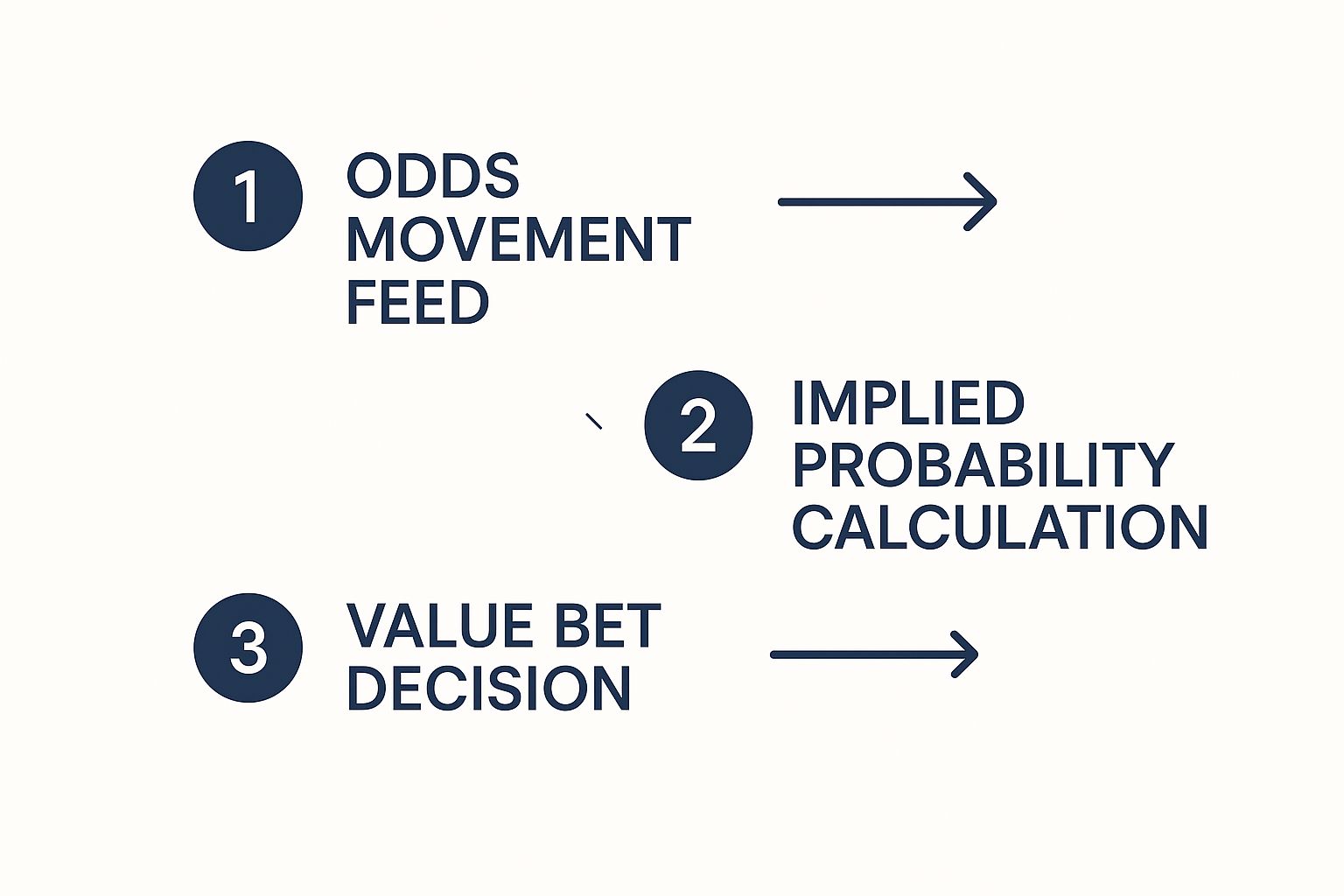
As you can see, it's a logical flow: you monitor the odds, calculate the probability, and make a clear-headed decision. It’s all about a systematic approach to hunting for profitable wagers based on data, not just a gut feeling.
Spotting Value: A Real-World Comparison
To see this in action, let's compare a standard bet with a true value bet. The difference lies in whether the odds offer a price that's better than the real probability of the event happening.
| Betting Scenario | Bookmaker's Implied Probability | Your Calculated Probability | Is It a Value Bet? |
|---|---|---|---|
| Standard Bet (Team to win at 1.80) | 55.6% (1/1.80) | 50% | No. The odds are shorter than the true chance. |
| Value Bet (Team to win at 2.50) | 40% (1/2.50) | 50% | Yes. Your 10% edge means this bet has positive value. |
The table makes it clear: value isn't just about finding a winner, it's about finding a price that overestimates the risk and underestimates the reward.
Putting Your Analysis into Action
Once you've spotted a discrepancy, the next step is to act. This is where confidence in your own assessment comes into play. Your research—whether it's based on team form, tactical matchups, or advanced metrics—has to be the foundation of your decision. You are essentially betting that your number is more accurate than the bookmaker’s.
Here’s a practical framework to get you started:
- Step 1: Calculate Your Own Probability: Before you even glance at the odds, figure out what you believe the true probability of an outcome is.
- Step 2: Find the Best Available Odds: Shop around. Compare different bookmakers to squeeze every last drop of value from the market.
- Step 3: Convert Odds to Implied Probability: Use the formula above to translate the bookie's price into a simple percentage.
- Step 4: Compare and Decide: If your calculated probability is higher than the implied probability, you've found your value bet. Pull the trigger.
This methodical process takes emotion and guesswork out of the equation. If you want to dive deeper into developing this kind of data-driven mindset, check out our guide on making high-confidence match predictions. By consistently applying this framework, you empower yourself to trust your own analysis over the bookmaker's price tag and systematically identify wagers with a real, positive expected value.
Reading the Story Told by Odds Movement
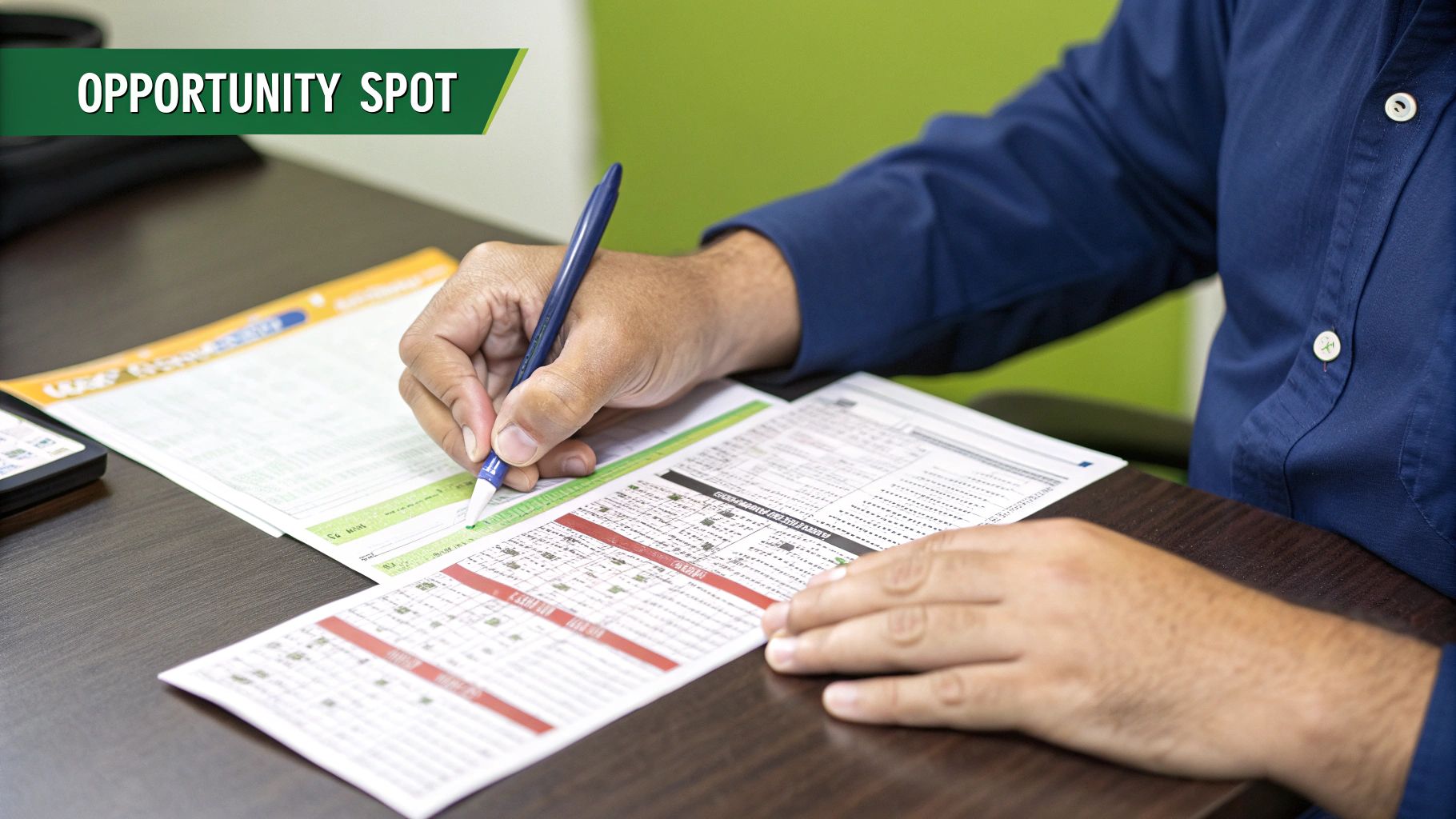
Odds are never set in stone. Think of them less like fixed prices and more like the constantly shifting charts of a stock exchange. They’re alive, reacting in real-time to new information and, most importantly, to where the money is going. If you can learn to read this story, you'll start to see opportunities that others miss.
This is especially crucial in today's bustling online scene. Take Romania, for example. The total gambling market revenue there soared past half a billion Euros in 2021, and a whopping 56.7% of that came from online betting. These are incredibly active markets where every little shift tells you something.
Each bounce and dip in the odds is a direct reaction to what the market is thinking. Your job is to decode those signals and find the true value bets & odds movement before the rest of the crowd catches on.
What Makes Betting Odds Change
At its heart, odds movement boils down to two things: the bookmaker adjusting their risk and new information changing the perceived probability of an outcome. When you see a price change, it’s a clear signal that something is different from when the market first opened.
Here are the main drivers you need to have on your radar:
- Weight of Money: This is the big one. If a flood of cash comes in on one team, the bookie will slash their odds to make them less attractive and, at the same time, lengthen the odds on the other side to encourage bets there. It’s all about balancing their books to guarantee a profit, no matter the result.
- Breaking News: A star player twisting an ankle in the warm-up, a sudden downpour changing pitch conditions, or a last-minute team sheet surprise can completely flip the script. Bookmakers have to react instantly to this kind of news.
- Market Sentiment: Sometimes, the public just gets behind a team. Media hype or a popular narrative can cause a wave of "public money" to pour in, shifting the odds without any new, concrete data. This is where sharp bettors can often find an edge, betting against the emotional crowd.
The crucial thing to remember is this: odds don't just show you the probability of an event. They show you what the market thinks the probability is. Your edge comes from finding the gap between that perception and reality.
Interpreting Steam and Drifts
In the world of betting, you'll hear the terms "steam" and "drift" a lot. They're just simple ways to describe the direction of the odds movement, and they offer powerful clues about where the smart money might be heading.
Steaming Odds (Shortening) When you see odds "steaming," it means they're getting shorter (for example, dropping from 3.00 to 2.50). This is a massive signal that a lot of money, often from professional bettors or syndicates, is backing that outcome. They've spotted value, and the market is moving to correct it.
Drifting Odds (Lengthening) On the flip side, "drifting" odds are getting longer (climbing from 2.50 up to 3.00). This usually means the market is losing confidence, or that the bulk of the money is going against that outcome. While a drift can make a bet seem less likely to win, it can also create fantastic value if your own analysis tells you the market has got it wrong.
Getting a feel for these signals is the first step to timing your bets perfectly. For a much deeper dive into using this data, check out our complete guide to real-time odds tracking. By learning to read the story that the odds are telling, you put yourself in the perfect position to pounce on value before it disappears.
Connecting Market Moves to Betting Opportunities
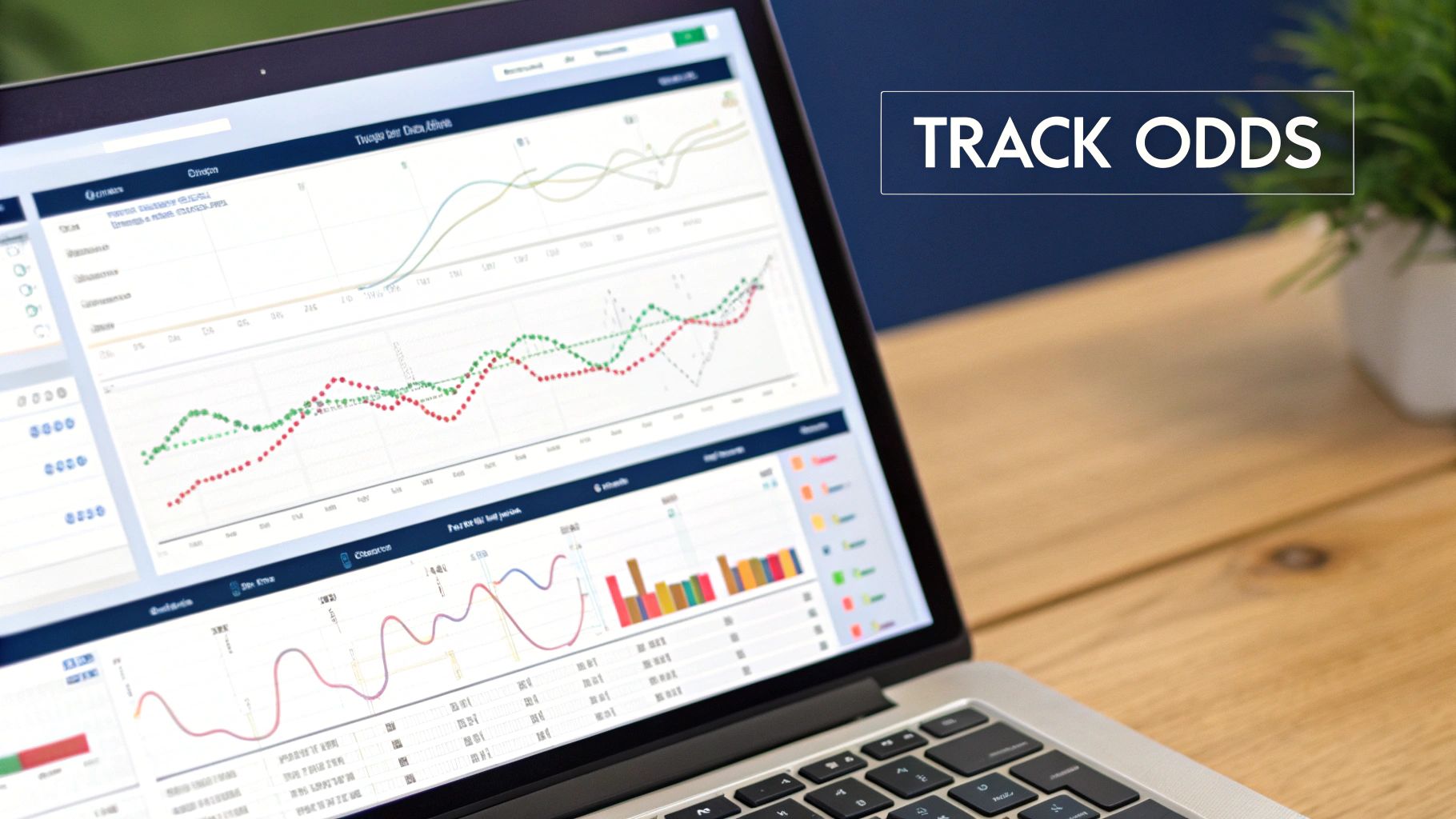
This is where the real magic happens. We've talked about value betting and we've talked about odds analysis, but now it's time to merge them into a single, powerful strategy. Think of it this way: market shifts don’t occur in a bubble. They actively create, reveal, and sometimes completely erase value.
The sharpest bettors don't just find a good price; they understand how market dynamics will affect that price from the moment they place their bet right up until kick-off. By learning to read these movements, you can learn to time your wagers perfectly, locking in the maximum value before the rest of the market catches on. It’s the art of turning market noise into a clear, actionable signal.
Reading the Scenarios in Shifting Odds
Odds movements tell a story. They reveal where the money is going and, just as importantly, where the general sentiment is leaning. How you react to these shifts depends entirely on the homework you did beforehand.
Let’s walk through the two most common scenarios you'll face.
Scenario 1: You Find Value, and the Odds Shorten
Picture this: you've analysed a match and flagged a team priced at 3.50 as a fantastic value bet. A few hours later, you check back and see their odds have dropped to 3.00.
This is usually a great sign. It suggests that other sharp bettors or a significant flood of money is backing your assessment, forcing the bookies to slash the price.
- Your Action: Consider this a big thumbs-up for your analysis. The key here is that you got in early. If you already secured the 3.50 odds, congratulations – you've just beaten the market. This is a textbook example of value bets & odds movement working in perfect harmony.
Scenario 2: You Find Value, and the Odds Drift
Now, let's flip that around. What if you identified that same team at 3.50 as a value pick, but the odds start to drift upwards to 4.00? This means the market is moving against you. It’s easy to feel your confidence wobble, but this can actually be a golden opportunity.
- Your Action: This is your cue to double-check everything. Is there some late team news you missed? Has a key player been ruled out? Or is this just the public piling money onto the heavy favourite, creating an artificial drift? If your original analysis still holds strong, the value of your bet just got even better. The market is offering you a bigger potential payout for an outcome you already believe is underpriced.
The goal is not to blindly follow every market move. It's to use the odds movement as a critical piece of feedback on your own analysis. Use it to confirm your insights or to double-check your work for anything you might have overlooked.
Interpreting Last-Minute Line Changes
The hour before an event is when the market is at its most volatile. This is when the "late money" pours in, often from professional syndicates with deep pockets and even deeper data models. Reading these last-minute shifts is a crucial skill.
A sharp, sudden drop in a team's odds right before kick-off can signal a massive piece of late-breaking information—like a confirmed starting lineup that heavily favours one side. Following this "smart money" can sometimes be a profitable move, but it demands quick thinking and a rock-solid understanding of the sport.
But this is also a time for caution. If you're placing a bet and the odds change at the exact moment you click "confirm," the bookmaker will ask you what to do. My advice? Be wary of the "accept all odds movement" option. That small pause to review the new, shorter odds allows you to decide if the value is still there. It’s your last line of defence against making a bet that is no longer profitable. Your initial judgement of value is what matters most.
Building Your Value Betting Toolkit
Knowing the theory behind value bets and odds movement is one thing, but turning that knowledge into consistent profit? That's a different game entirely. Think of it like a master craftsperson—you need the right tools and habits to do your best work. It's time to move beyond just spotting value and start building a solid system that will actually support your long-term goals.
This system rests on a few core principles of disciplined betting. It’s about cultivating a professional mindset that can handle the inevitable highs and lows of wagering. With sports betting revenue in Romania expected to climb to US$256.30 million by 2025, you need a structured approach to get your slice of the pie. You can dive deeper into these industry growth projections on Statista.com.
Essential Tools and Habits
Let's start building that professional toolkit. These aren't just helpful hints; they're the absolute foundation of any serious betting strategy.
- Odds Comparison Sites: Make this a non-negotiable first step. Never place a bet without scanning the market. Using an odds comparison tool guarantees you’re locking in the best possible price, which is the easiest way to maximise your returns over the long haul.
- Disciplined Bankroll Management: Your betting fund is your business capital. Treat it that way. The "unit" system is a classic for a reason: you only risk a small fraction, typically 1-3%, of your total bankroll on a single wager. This discipline is what keeps you in the game, even during a rough patch.
- Record Keeping: You have to track every single bet. Log the stake, the odds, the outcome, and why you made the pick. This isn't busywork—this data is pure gold for figuring out what's working, what's not, and where your real edge lies.
Long-term profitability doesn't come from a single massive win. It's built brick by brick, through the consistent application of disciplined processes that give you a statistical edge over hundreds of bets.
Finding Your Niche
Don't try to be a jack-of-all-trades. Bookmakers are forced to cover thousands of events, which means their knowledge is often a mile wide and an inch deep, especially in less popular markets.
Herein lies your opportunity. Find a niche and own it. Whether it's Romania's Liga II or the Norwegian second division, you can develop a much deeper understanding of the teams, players, and tactics than the odds compilers. This specialised insight is how you unearth mispriced odds that the rest of the market completely misses.
Finally, the most powerful tool you have is your own mindset. Emotion is the enemy of value. A losing streak will tempt you to chase your losses with bigger, desperate bets. A winning run can make you feel invincible and lead to overconfidence. Your strategy is your anchor in these emotional storms. Trust your analysis, stick to your bankroll rules, and view every bet as a calculated decision based on value, not a hopeful punt. That unshakeable discipline is what truly separates the casual punter from the sharp, profitable bettor.
Common Mistakes That Erode Your Bankroll
Spotting value is one thing, but keeping your bankroll safe from silly mistakes is a whole different ball game. It doesn't matter how long you've been betting; even seasoned pros can fall into common traps that slowly drain their profits. To build a solid, disciplined approach, you have to be on guard against these pitfalls. Otherwise, all that hard work finding an edge goes right out the window.
One of the biggest blunders is thinking long odds automatically equal good value. Sure, that massive underdog at 10.00 looks tempting. But if their real chance of winning is even worse than what those odds imply, it’s a terrible bet. Value is all about the gap between the price and the actual probability, not just the size of the potential payout. Always do the maths before letting a big number lure you in.
Another way bettors leak money is by blindly "chasing steam." When you see odds dropping like a stone, the impulse is to assume the "smart money" is piling on and to quickly follow suit. Sometimes that's true, but it can just as easily be public hype moving the line. If you haven't done your own homework to confirm there's real value, you’re just chasing the crowd—and usually after the best price is long gone.
Overlooking Cognitive Biases
At the end of the day, our own minds can be our worst enemies in betting. We're all wired with biases that mess with our judgement and push us toward bad decisions. The first step to beating them is knowing they exist.
Here are two of the most damaging ones to watch out for:
- Confirmation Bias: This is our natural tendency to hunt for information that backs up what we already believe. If you've got a good feeling about a team, you'll subconsciously look for stats that prove you right and ignore anything that suggests you might be wrong.
- Recency Bias: This one makes us put way too much importance on what just happened. A team that's won three on the bounce isn't automatically a value pick for their next match, just like a great team isn't suddenly a lost cause after one bad performance.
A disciplined bettor doesn’t look for reasons to justify a bet they want to make. Instead, they let the data guide them to the bet they should make, regardless of personal feelings.
Poor Staking and Bankroll Management
Finally, the quickest path to ruin is terrible bankroll management. We’ve all been there: chasing losses after a tough loss or getting cocky during a hot streak. These are classic emotional reactions, and without a strict staking plan, a couple of bad calls can undo weeks of patient work.
Managing your money properly isn't just a good idea; it's a non-negotiable skill if you want to be successful in the long run. Our dedicated guide to tracking units won and lost gives you a complete blueprint for this crucial discipline. By steering clear of these common mistakes, you'll build a tough, systematic approach that protects your capital and lets your analytical edge truly shine.
Got More Questions About Value Betting?
If you're still piecing it all together, don't worry. Let's break it down one more time. The heart of value betting isn't just a blind punt on a longshot; it's about finding a price that doesn't reflect the true odds of something happening.
Think of it this way: a £10 bet at odds of 3.0 on a team you've calculated has a 40% chance of winning is a fantastic value bet. On the flip side, backing a heavy favourite at 1.50 with that same tenner, even if they have a 70% chance to win, is actually poor value. It's all about whether the odds are paying you more than they should for the risk you're taking.
So, where do shifting odds fit in? Think of them as whispers from the market. When odds start to drop, it's often a sign that the "smart money" from professional bettors is pouring in, validating your own analysis. But if you see odds drifting outwards, it doesn't automatically mean you're wrong. If you stand by your research, those longer odds just make your potential value bet even juicier.
At the end of the day, it's a constant hunt for that sweet spot—the gap between the bookmaker's price and the real probability.
Sind Sie bereit, mit dem Gewinnen anzufangen?
Melden Sie sich bei OddsHaven an und erhalten Sie sofortigen Zugang zu KI-gestützten Vorhersagen mit einer Gewinnquote von 87 % bei Tipps mit hohem Vertrauen.
Testen Sie OddsHaven kostenlos für 5 Tage

